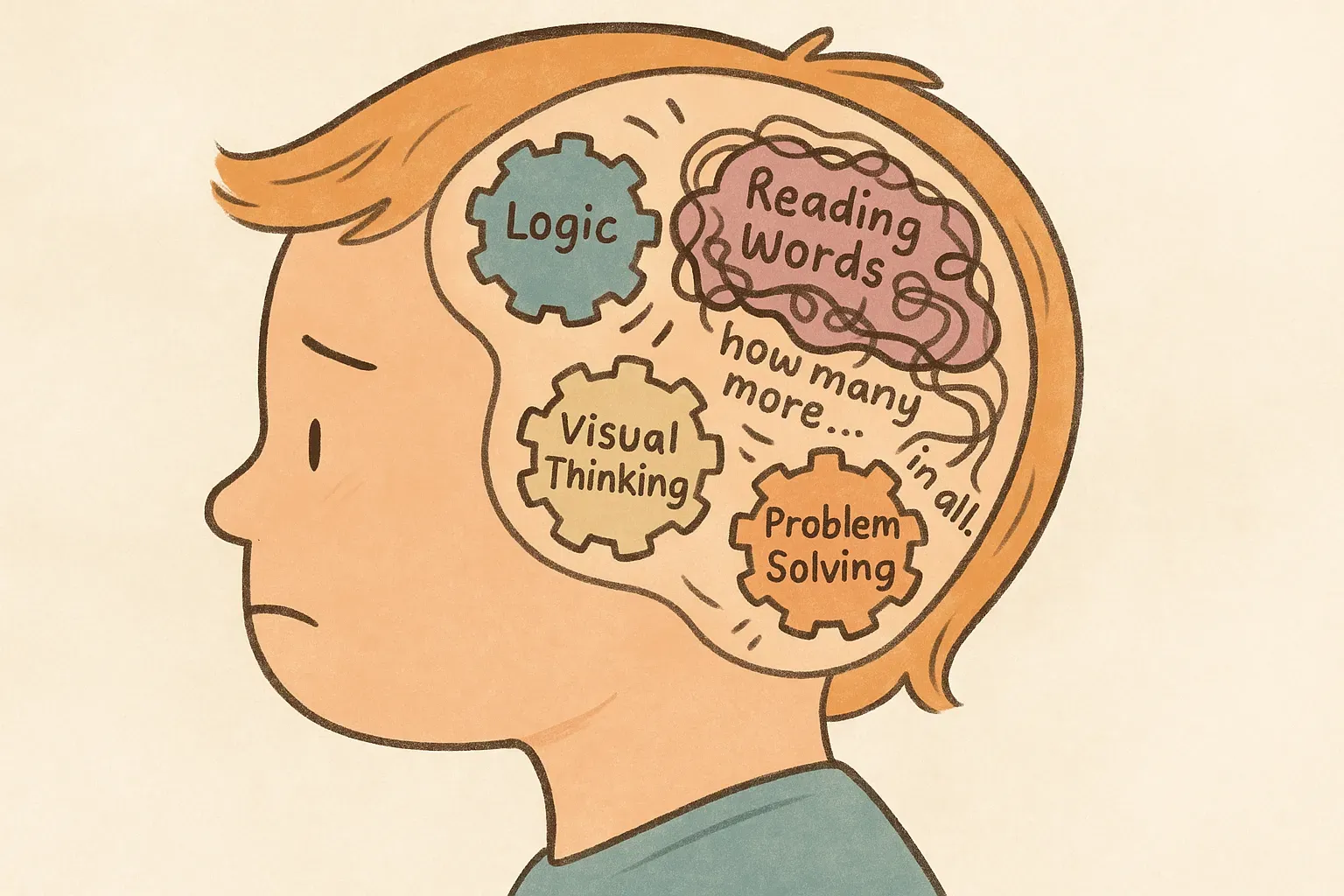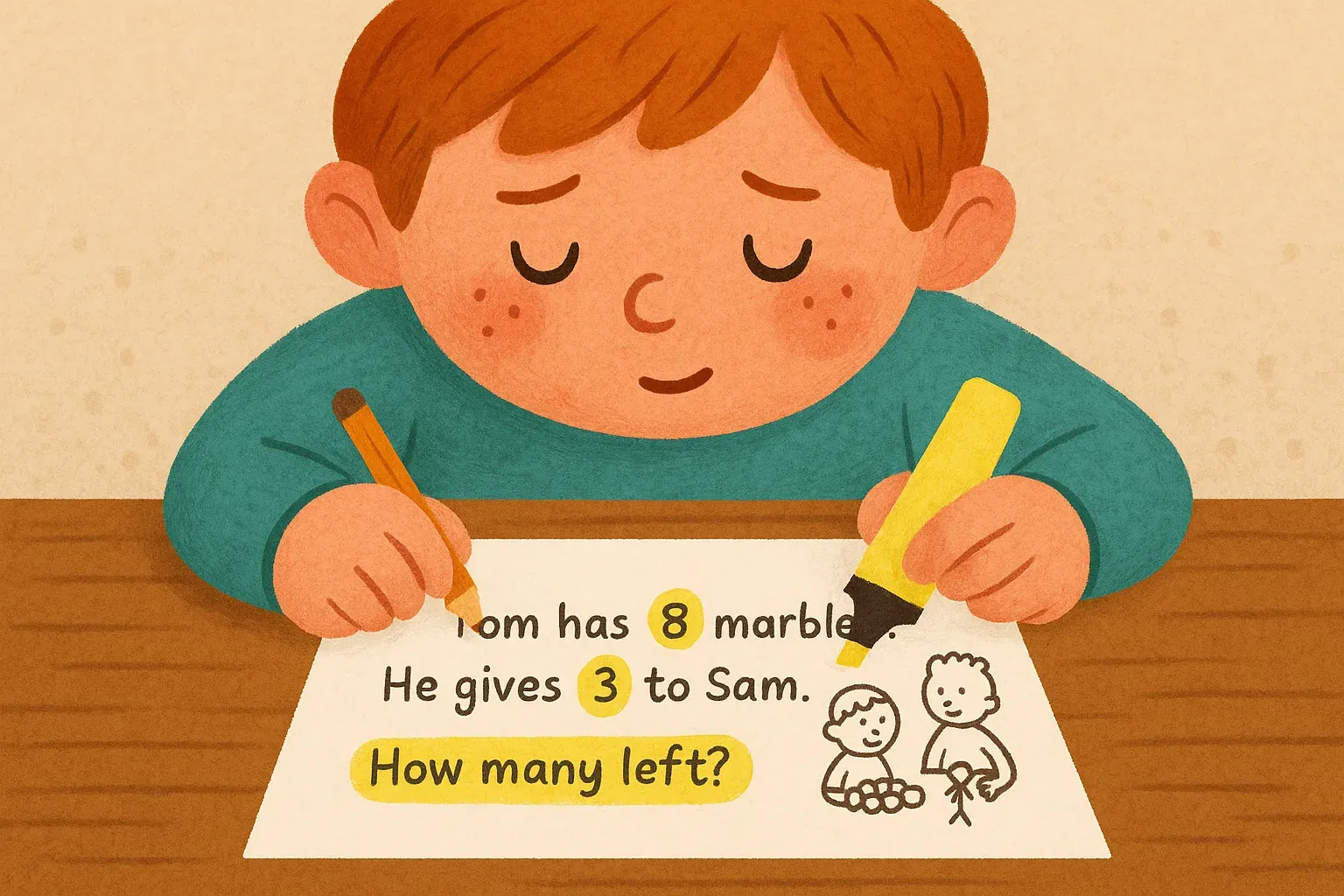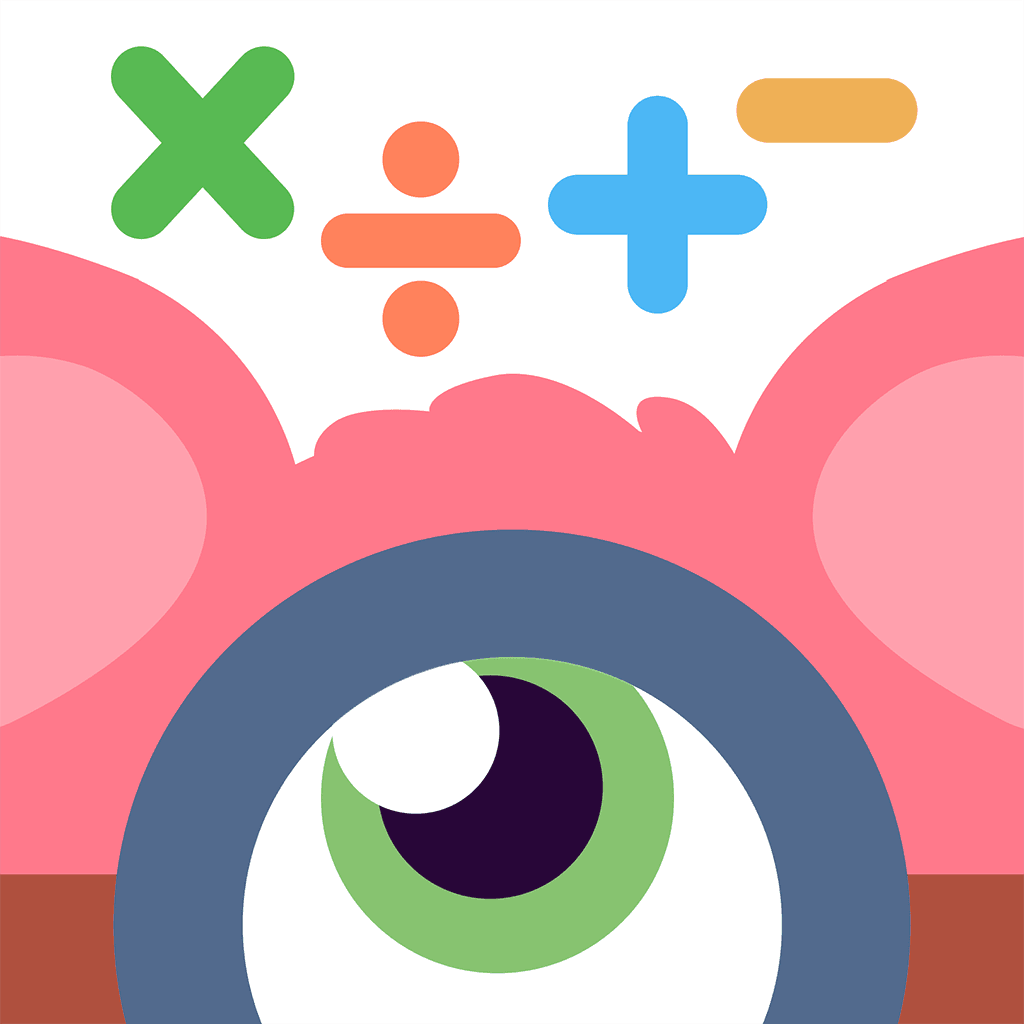Math & Dyslexia: Why Word Problems Trip Kids Up (And 6 Fixes)
TLDR;
Dyslexia can make word problems in math particularly challenging for kids due to difficulties with language comprehension, sequencing, and working memory. This post outlines six evidence-based strategies to help children with dyslexia overcome these challenges and succeed in math.
Introduction
Dyslexia is a language-based learning disability that primarily affects reading and language processing. However, its impact extends to other subjects, including math, particularly when it involves reading and interpreting word problems. For children aged 5-10, with or without ADHD, word problems can be a significant hurdle because they require both mathematical understanding and the ability to comprehend and translate written language into mathematical operations. This can be especially challenging for kids with dyslexia, who may struggle with decoding text and processing complex instructions.
In this post, we explore why word problems are difficult for children with dyslexia and provide six practical, research-backed strategies to help them succeed in math. These strategies are designed to be accessible for parents and educators, offering clear, actionable steps to support young learners.
Why Word Problems Are Challenging for Kids with Dyslexia
Word problems combine language and math skills, creating unique challenges for children with dyslexia. Research highlights several reasons why these problems are particularly difficult:
- Language Comprehension: Word problems require reading and understanding text, which can be tough for kids with dyslexia who struggle with decoding words and grasping sentence structures. This is due to difficulties with phonological processing, a core challenge in dyslexia (Landerl et al., 2009).
- Sequencing and Order: Solving word problems often involves following a sequence of steps or understanding the order of operations, which can be challenging for children with dyslexia who may have trouble with sequential processing.
- Working Memory: Word problems require holding multiple pieces of information in memory while performing calculations, a task that can be taxing for kids with weaker working memory skills, often seen in dyslexia.
- Symbol and Word Confusion: Dyslexia can lead to confusion between similar-looking symbols or words, such as "plus" and "times" or "sum" and "difference," which are critical for solving word problems.

These challenges are supported by research. For instance, Landerl et al. (2009) found that children with dyslexia often struggle with phonological processing, impacting their ability to read and understand word problems. Similarly, Snowling (2011) notes that dyslexia can affect mathematical performance, particularly in tasks requiring language processing. For children with ADHD, these challenges can be compounded by difficulties with attention and working memory, making tailored strategies even more critical (Dyslexia Action, 2024).
6 Evidence-Based Fixes
Here are six strategies, grounded in research, to help children with dyslexia tackle word problems effectively. These approaches are designed to support kids aged 5-10, including those with ADHD, by addressing their unique learning needs.

1. Explicit Instruction on Math Vocabulary and Concepts
- What It Is: Directly teach math-specific vocabulary, such as "sum," "difference," "are left", "product," and "quotient," using clear explanations and relatable examples.
- Why It Works: Children with dyslexia may not intuitively grasp math vocabulary due to language processing difficulties. Explicit instruction helps build a strong foundation for understanding word problems.
- Example: When teaching addition, explain that "sum" means the total when two numbers are added. Use a number line or counters to show, for instance, that 3 + 4 = 7 is the "sum."
- Reference: Hardy and Clemens (2024) emphasize explicit teaching of word-problem-specific vocabulary as a key strategy for supporting students with dyslexia.
2. Multisensory Learning Approaches
- What It Is: Engage multiple senses—visual, auditory, and kinesthetic—using tools like manipulatives, diagrams, or acting out problems.
- Why It Works: Multisensory methods activate different brain pathways, enhancing understanding and retention for children with dyslexia. This approach is particularly effective for kids with ADHD, as it boosts engagement.
- Example: For a word problem like "If 3 friends share 12 candies equally, how many does each get?" have kids use physical candies to divide into groups, reinforcing the concept of division. You can also use the Singapore bar method that visualises the word problem.
- Reference: The International Dyslexia Association (2022) recommends multisensory learning as a cornerstone of effective instruction for dyslexia.
3. Adapting Word Problems for Readability
- What It Is: Simplify the language in word problems or use visual supports like diagrams or charts to make them easier to understand.
- Why It Works: Reducing the reading load allows kids to focus on the math, bypassing language processing challenges.
- Example: Rewrite a problem like "John has 5 apples and gives 2 to his friend" as bullet points: "John has 5 apples. He gives 2 away. How many are left?" Add a diagram showing 5 apples with 2 crossed out.
- Reference: Hardy and Clemens (2024) advocate adapting word problems for readability to support students with dyslexia.
4. Teaching Problem-Solving Strategies
- What It Is: Teach a systematic approach to solving word problems, such as identifying the question, underlining key information, choosing the operation, and checking the work.
- Why It Works: A structured method reduces cognitive overload and helps kids organize their thoughts, which is especially helpful for those with ADHD who may struggle with focus.
- Example: Use the "UPS" acronym (Understand, Plan, Solve) to guide kids: Understand the question, Plan the steps, and Solve the problem. For example, underline "how many" to identify the question and list numbers to plan.
- Reference: Structured problem-solving strategies are widely supported in math education research for students with learning disabilities.
5. Using Graphic Organizers
- What It Is: Provide tools like tables, charts, or flowcharts to help kids organize information from word problems.
- Why It Works: Visual organizers make abstract concepts concrete, helping kids see relationships and structure their thinking.
- Example: For a problem like "A car travels 60 miles in 2 hours. What is the speed?" use a table to list distance (60 miles), time (2 hours), and speed (unknown), guiding kids to the formula speed = distance ÷ time.
- Reference: Graphic organizers are a common tool in special education for supporting students with learning disabilities, including dyslexia.
6. Providing Scaffolded Support
- What It Is: Offer a gradual release of responsibility, starting with teacher-led instruction, moving to guided practice, and then independent work with check-ins.
- Why It Works: Scaffolding builds confidence and skills step-by-step, reducing frustration and supporting success, particularly for kids with ADHD who may need shorter, focused sessions.
- Example: Solve a word problem together, then guide the child through a similar problem, and finally let them try one independently with feedback.
- Reference: Scaffolded instruction is a well-established practice in both general and special education research.
Supporting Kids with ADHD
For children with both dyslexia and ADHD, these strategies are particularly effective. ADHD can exacerbate challenges with working memory and attention, making word problems even more daunting. Strategies like multisensory learning and scaffolded support help maintain engagement and reduce overwhelm. The Dyslexia Action Literacy Programme (2024) suggests shorter sessions and varied formats to accommodate attention difficulties, which can be applied to math instruction.
Conclusion
Word problems can be a significant challenge for children with dyslexia due to the interplay of language and math skills. However, with strategies like explicit instruction, multisensory learning, simplified language, structured problem-solving, graphic organizers, and scaffolded support, parents and educators can help kids aged 5-10, with or without ADHD, build the skills and confidence to succeed in math. Tailoring these approaches to each child’s needs and monitoring progress is key to fostering long-term success.
While word problems might trip some Dyslexic kids, many kids struggle even before reaching there, while learning Number Sense and Math Fact Fluency. For them, consider trying out Monster Math - a Neuroinclusive, research-backed and game-based Math learning program.
Related Reads
FAQ
Can children with dyslexia succeed in math?
Yes, with appropriate support, children with dyslexia can excel in math. Strategies like those outlined here address their specific challenges, helping them build skills and confidence.
Are there tools or apps that can help?
Assistive technologies like text-to-speech software (e.g., Read&Write) and math apps (e.g., Mathway) can support reading and problem-solving for kids with dyslexia.
How can I tell if my child has dyslexia?
Signs include difficulties with reading, spelling, writing, and sometimes math, particularly word problems. Consult a psychologist or educational specialist for a formal assessment.
Is dyslexia only about reading?
No, dyslexia affects language processing, impacting areas like writing, spelling, and understanding word problems in math, in addition to reading.
What age is best to start interventions for dyslexia?
Early intervention, ideally in kindergarten or first grade, is most effective to support foundational skills and prevent long-term challenges.

